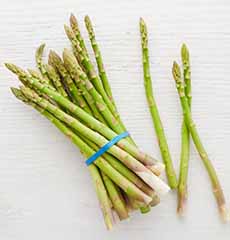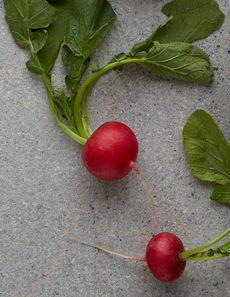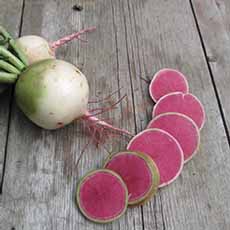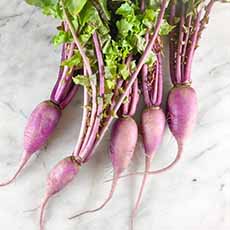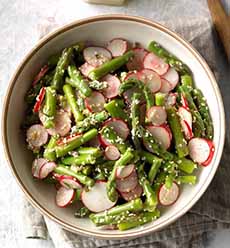Spring Salad Recipe: Asparagus & Radishes & The History Of Radishes
|
It’s easy to put together a spring salad of asparagus and radishes. Most of us are familiar with the crimson radish, and maybe even black radish and white radish (the shredded daikon served with sashimi). If you’re lucky, you’ve enjoyed the beauty of a watermelon radish (photo # 3) or another specialty radish (photo #4—check your farmers market). If you’re a radish lover, take a look at these heirloom radishes. We’d never seen the Chinese Green Luobo Radish (Qingluobo), with lime-green skin and flesh; and the purple-skinned Malaga Radish that looks like a beet. Some radishes are small globes, others have pointy tips, still others are the shape of carrots or turnips. The amazing Rat’s Tail Radish from Thailand doesn’t look like a radish at all. It’s a very long, slender green pod with radish “seeds” inside, and was grown in U.S. gardens in the 1860s. The Zlata Radish from Czechoslovakia is the color of gold beets. Radishes, botanically known as Raphanus sativus, are actually cabbage relatives that originated in Asia. They are a member of the Brassicaceae family of vegetables that is famed for its anti-carcinogenic properties. There are small varieties for salads and radishes the size of potatoes that in pre-refrigeration times could be stored through the winter. Whether you buy them or grow them, celebrate spring with this refreshing radish and asparagus salad. It’s from Katchkie Farm in Kinderhook, New York, which uses its micro arugula in the recipe. > A brief history of radishes is below. Ingredients For 3 Servings 1. PEEL the asparagus and blanch in salted boiling water then shock in ice water, drain and reserve. 2. PREPARE the Blood Orange Vinaigrette. Whisk together the orange juice, vinegar, minced shallot, salt and pepper. Add the olive oil while continuing to whisk. Taste and adjust seasoning as necessary. 3. TOSS a bit of the vinaigrette with the asparagus. 5. TOAST the pistachios in a dry skillet over medium heat. Remove and set aside to cool. 6. PLACE the radishes, oranges, and pistachio in a salad bowl, then add the lemon juice, olive oil, salt, and pepper. Toss together and adjust the seasoning to taste. 7. PLATE: Place four asparagus on each plate. Spoon the radish mixture on top. Garnish with some micro arugula and drizzle with vinaigrette. ______________ *If you can’t find blood oranges, see if the fresh juice section of the store has blood orange juice. Or, substitute orange or tangerine juice. †Substitute white wine vinegar. ‡Substitute other microgreens or sprouts. |
|
|
|
THE HISTORY OF RADISHES Radishes, a root vegetable, originated in China thousands of years ago. Wild varieties can still be found there. In prehistoric times, the radish spread to Middle Asia, where many different forms were developed. Soon afterward, the radish spread to the Mediterranean. Radishes were extensively cultivated in Egypt during the time of the Pharaohs. Ancient records show that radishes were eaten before the pyramids were built. The first written records that mention radishes come from 3rd century B.C.E. [source]. They became an important food in ancient Greece and Rome, as well. But the radish did not spread throughout the rest of Europe until much later. The other radishes grown in the U.S. are the black radish, daikon, California Mammoth White, and White Icicle. You may also find exotic varieties like the Purple Ninja (photo #4). Radish leaves are edible. Use them in your own salads, soups (especially potato soup), or sautéed as a side dish. (Guinea pigs, hamsters, and rabbits are also big fans of the leaves.) The leaves also look pretty as crudites or plate garnishes Fun fact: The “hot” flavor of the radish is found in the skin. If you peel the radish, you lose the heat—and most of the flavor [source: USDA & Wisconsin Department Of Public Instruction]. Radish is a rich source of ascorbic and folic acid, potassium, vitamin B6, riboflavin, magnesium, copper, and calcium. When buying radishes, choose smaller ones: they have a better flavor and texture. If you cut off the tops of the radishes when you buy them and store them in plastic bags, they can last up to two weeks in the fridge. CHECK OUT WHAT’S HAPPENING ON OUR HOME PAGE, THENIBBLE.COM. |
||
